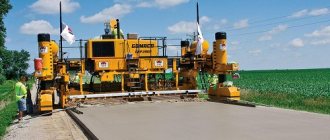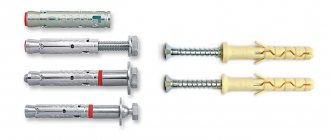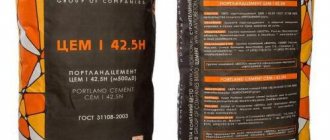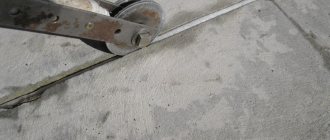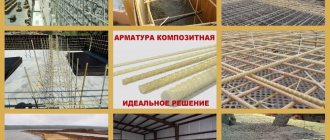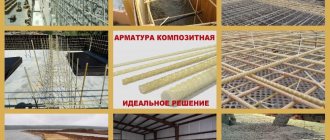Natural ASG is a mixture of sand and gravel, as they say, “only from a quarry.” It is not sifted or purified, and contains only up to 20% gravel, as well as impurities such as clay and limestone. The gravel itself in such a mixture is quite coarse, heterogeneous, both igneous and residual rocks. And OPGS is purified material, impurities are removed from it and gravel is added, bringing its share to 70%. At the same time, the gravel in the enriched mixture is smaller. What material should I choose for the job?
ASG from a quarry: large fraction, many impurities
Component Requirements
Depending on the specifics of the deposits, the composition and quality of sand and gravel, their proportions differ significantly. Depending on the percentage of large components of the fraction of 5 mm or more, GOST distinguishes several groups of pgs and opgs:
- 15…25%;
- 25…35%;
- 35…50%;
- 50…65%;
- 65…75%.
OPGS is an enriched mixture of sand and stones that can be brought to the desired quality. For example, in a local deposit it is possible to extract only PGS with a 35% content of durable gravel, and the buyer needs 65% to prepare a concrete mixture for the construction of the foundation of a certain structure. Many suppliers carry out the fortification procedure.
Frost resistance of PGS.
Resistance to temperature drop is an important criterion, given the climatic conditions of our country. Concrete structures begin to deteriorate over time, only some faster and others more slowly. What does this depend on?
It turns out that frost resistance indicators can be different. Frost resistance indicates a certain amount of frequency or cycles of freezing and thawing that will not have a negative effect. After the end of the number of cycles, concrete products using ASG will begin to crumble. If the gravel contains many pores, it will have increased moisture permeability, and freezing water will lead to the destruction of concrete.
Therefore, consider this data when purchasing, especially if you are interested in long-term construction. For temporary and non-serious buildings, as well as as backfill, you can use ordinary ASG, regardless of the degree of frost resistance.
For high-quality construction work, it is necessary to use AGS with a frost resistance grade of at least 300. Three main groups of frost resistance can be distinguished:
- It is permissible to use only indoors - F15, F25, F50, F100.
- The average frost resistance is F150, F200.
- High frost resistance, allowed for outdoor use - F300, F400.
COMPOSITION OF SAND-GRAVEL MIXTURE AND GOSTS
Since the sand-gravel mixture contains two elements - gravel and sand, its properties and characteristics are regulated by two state standards - GOST 8267-93 “Crushed stone and gravel from dense rocks for construction work. Technical conditions" and GOST 8736-93 "Sand for construction work". These documents determine the permissible amount of clay particles, the shape and size of grains, and background radiation.
According to GOST, natural sand ASG contains at least 10% gravel of the total mass. This mixture is used in road construction as drainage and for making a top layer. The enriched composition (OPGS) can contain a maximum of 70% gravel and 30% sand. According to the gravel component, the following groups are distinguished: 65-75%, 50-65%, 35-50% and 15-25%. All of them are used in the production of concrete and creating foundations for industrial and residential buildings.
According to GOST, the content of elements such as dust and clay should not be more than 5% in conventional ASG and 3% in enriched one.
It is mandatory to comply with the following standards for the specific efficiency of natural radionuclides (Aeff) - 370 Bq/kg for buildings; from 370 Bq/kg to 740 Bq/kg – industrial buildings; from 740 Bq/kg to 1500 Bq/kg – roads and airfields.
GOST 23735-79 “Sand-gravel mixtures for construction work” is also important. Technical conditions". In addition to the technical characteristics of the material, this document regulates the rules of acceptance and shipment, storage and labeling conditions, which are strictly observed by bona fide manufacturers. Tests of ASG and OPGS are carried out in accordance with GOST 8269.0 and GOST 8735. To study the material data, the mixture is divided into gravel and sand.
ASG concrete for foundation
Concrete grades are prepared from an enriched mixture of gravel and sand:
- M150 - for foundations for small one-story buildings;
- M200 – for strip and slab foundations;
- M250 – for monolithic and slab foundations;
- M300 – for monolithic foundations;
- M400 – with accelerated setting for particularly strong foundations.
To improve the adhesion of the mixed components, Portland cement with a calcium silicate content of up to 80% is used to prepare concrete. This allows concrete to be mixed at low temperatures, but not below +16 0 C. The content of foreign impurities in cement should not exceed 20%. Special marking of cement, designated by the letter “D”, indicates the percentage of undesirable additives in it.
One of the most dangerous aspects in construction is low-quality materials, and in our case this applies most of all to concrete for the foundation. Prices for concrete in Kazan vary greatly: from 3300 to 4540 per cubic meter of concrete of the same brand (in this case, M200 concrete in July 2012). Think: why could there be such a difference? Why are those who sell concrete for 4,540 rubles not bankrupt, but prosperous organizations, and they buy from them? Maybe those who buy for a high price know something that those who buy for 3300 do not know?
One of the most dangerous aspects in construction is low-quality materials, and in our case this applies most of all to concrete for the foundation. Prices for concrete in Kazan vary greatly: from 3300 to 4540 per cubic meter of concrete of the same brand (in this case, M200 concrete in July 2012). Think: why could there be such a difference? Why are those who sell concrete for 4,540 rubles not bankrupt, but prosperous organizations, and they buy from them? Maybe those who buy for a high price know something that those who buy for 3300 do not know? But they know this. Concrete has a complex composition, more complex than it might seem. The components that make up concrete, although identical at first glance, can be of very different quality. One of our colleagues is engaged in the implementation of such components, and this is what he explained. For concrete, OPGS is used (the difference from ASG is that OPGS contains more gravel). The gravel content of OPGS in concrete for the foundation must be at least 70%. The best OPGS is “Grocery”, its gravel content is 80-90%. It is also the most expensive - 800 rubles. per ton. In addition, for concrete, some concrete producers buy ASG, where the gravel content is 40% or even less (price about 400 rubles/ton). The rest is sand. Even if this ASG is mixed with cement in the correct proportion, your concrete will begin to crumble over time. The second important point is cement. It can also be very different. The first dependence is the manufacturer. The worst one (it’s also one of the most popular in the city, we won’t name the brand here) contains a lot of limestone, which is very bad. Suitable for masonry, but not for foundations. The second dependence is the production date. In six months, cement loses its grade strength by 30%, in 2 years - more than 50%. Anyone who thinks that all concrete producers are zealously concerned about the shelf life of cement is greatly mistaken. Moreover, some people deliberately buy old cement - after all, it is cheaper, often sold at a bargain price, so as not to be disposed of. Now let’s look at the classic situation. You have ordered the concrete grade you require. And the manufacturer even mixed everything in the right proportion. But if there is too much sand in the OPGS, and the cement is old, then even if a specific brand is indicated in the invoices, say M200 or M300, it will never gain this brand strength. Yes, you will have invoices and other documents, but what good is this if the concrete has already been poured into the foundation? You can sue, conduct examinations at your own expense, seek the truth, but do you need this or that for the house to stand? There is an opinion that professionals can determine its quality by the appearance of liquid concrete. Yes, you can notice the difference if you want. But even an examination will not give an exact answer at the time of pouring! Only on the 14th day can the examination state that “the hardening kinetics does not correspond to the brand name,” but the exact result will be on the 28th day. Conclusion: it is extremely important at the time of pouring to be confident in the quality of the concrete, and this is achieved not just by the invoices that you received, but also by the quality certificate of the concrete batch and the reputation of the organization that supplied it to you.
Portland slag cement is also suitable for the construction of not only foundations, but also walls and basements. Be sure to think about what will serve as a concrete filler. For this case, it is imperative to use a mixture of sand and gravel. You can also use a mixture of crushed stone and sand.
PGS and its types
First of all, let's define what PGS is. It's very simple, it's a mixture of sand and gravel. It wouldn't hurt you to know the origin of this material. This mixture is extracted from the river or seabed itself. The nature of the place from which the mixture was taken is of great importance. This will characterize its quality and properties. The main criterion that you should pay attention to is the bonding properties of the mixture. Sand-gravel mixture is a very common material that is used in the manufacture of various structures. These can be reinforced concrete or concrete structures. Sand and gravel mixture has many types and types. Each type of ASG differs in its composition, and more specifically in the ratio of its main components.
Depending on the proportions of sand and gravel, a large number of types of sand and gravel mixtures are distinguished. Separation also occurs depending on the size of the gravel grains and the presence or absence of clay or silt particles. The grain sizes of the components of the sand-gravel mixture, their strength and frost resistance are also of great importance. The most common type of ASG should be highlighted. It is an enriched sand and gravel mixture. The main difference between this type and the classic sand-gravel mixture is the larger amount of gravel in the mixture. This is a fairly significant difference, which significantly changes the properties of the mixture. Please pay attention to this when choosing materials. The enriched sand-gravel mixture contains up to 75% gravel.
So that you can better feel the difference between these two mixtures, let us inform you that the share of gravel in a classic ASG will be no more than 20%. This is their main difference, which must be taken into account. Concrete from these components is usually created from cement, water and OPGS or OPGS. In order for you to create the best quality concrete, we advise you to maintain the proportions that we give below. So, to prepare concrete you will need to mix ½ part water, 4 parts enriched sand-gravel mixture and 1 part cement, how could you do without it. These proportions must be calculated depending on the weight of the material. If desired, you can add sand. But before you do this, you must take into account the percentage of this material in the most enriched sand and gravel mixture. The proportions should be strictly observed, and then the end result will be an excellent product. As for the classic ASG and its proportions, everything will depend directly on the brand of concrete taken that you intend to obtain.
The brand of cement and other components that you will use in the production of concrete is also of great importance. The ratio of the components can also be used at home. It's not too difficult. To make it easier for you, use a metal mesh through which you can sift a certain part of the mixture. Usually, sand should not be added to this type, because a sufficient amount of this material is already contained in the sand and gravel mixture. There are certain cases when even crushed stone is added to the ASG. The specifics of concrete preparation techniques should be taken very seriously. If you plan to prepare concrete for pouring a foundation, you should use a ratio of 1 to 8. Thus, you will need 8 parts of ASG and only one part of cement. This is the most ideal ratio, rest assured.
PGS concrete for foundation
If you need concrete directly for the foundation, you should consider some nuances.
So, you will need to prepare a concrete mixture. It will consist of crushed stone, gravel and cement. Don't forget to add water and sand. These are important elements, without which concrete will not work. The most important thing is to take into account the necessary proportions. The cement will serve as a binder. Here, too, you should choose the best option. We advise you to stick to Portland cement. Specialists recommend using this particular substance. It has excellent astringent qualities. It is produced in several variations. The most famous brands are 300, 600,500. You can also shoot a variety of 400. Be careful, because this material has an extraordinary ability to quickly set. For this reason, remember that it must be used for its intended purpose within a maximum of two hours. If your plans include building a small house, you need to choose Portland cement grade 400. Or in this case, the proposed material of type 300 will be appropriate. It will perfectly create the foundation you need without unnecessary difficulties. Don't skimp on the quality of the substance. This can lead to big problems. It may simply not set. Cement that belongs to grade 600 is excellent for reinforced concrete structures. This is due to its great strength. Portland slag cement has its own characteristics. Firstly, it has a grayish color, pay attention to this when choosing building materials. But when you prepare a concrete mixture from it, the color will change and become darker. If this does not happen, then the material is of poor quality. Be carefull.
Portland slag cement can be of three types. There are 400, 300 or 200. If you are going to build small houses, these types of Portland slag cement are best suited. This material is unique in nature. It has irreplaceable qualities of a building material. Portland slag cement has waterproof properties. This will protect your home from the negative effects of groundwater. The foundation will not rot, and your house will be safe and sound. Portland slag cement is also suitable for constructing not only the foundation, but also walls and basements. Be sure to think about what will serve as a concrete filler. For this case, it is imperative to use a mixture of sand and gravel. You can also use a mixture of crushed stone and sand. Select the filler wisely, because the quality of the concrete, and most importantly its strength, depends on this. It is important to decide on the size of the gravel. For standard concrete, grains up to 80 mm in size are usually used. For reinforced concrete, grains up to 30 mm in size are taken. Pay attention to this moment. Large stones are placed in the concrete intended for the foundation. This is explained by the economy of the concrete mixture. You can also watch the video Concrete on PGS (concrete on PGS)
If foreign impurities are detected in quantities exceeding the standard, the mixture must be purified. This is done in two ways:
Explanation of ASG: sand and gravel mixture. As the name suggests, it contains sand and gravel of different fractions in certain quantities. Accordingly, the requirements for these materials are imposed by 2 regulatory documents:
- GOST 8267 for gravel;
- GOST 8736 for sand.
To facilitate the control process, a unified GOST 23735-79 “Sand-gravel mixtures” was created. According to the document, the mixture should include:
- the amount of gravel fraction of more than 5 mm should be in the range of 5...95%;
- the remaining part is sands from coarse to fine.
Not every mixture of sand and gravel is suitable for construction purposes, but with a certain qualitative composition, in which the predominant majority should be a large component. If the natural gravel mass lacks large particles, it is artificially enriched with them up to 75%. The result is a so-called enriched sand-gravel mixture, most suitable for the preparation of concrete and asphalt concrete.
OPGS ~ What is this?
Baths 2x3Baths 3x3Baths 3x4Baths 3x5Baths 3x6Baths 4x5Baths 4x6Baths 6x6Other sizeSummer bathsWinter bathsWith atticCustomer projects
OPGS – Gravel-enriched sand-gravel mixture. It is easy to distinguish by eye; the number of pebbles ranging in size from 1-3 cm is much greater than that of ordinary sand. We use OPGS for pouring strip foundations. Let's figure out why?
What did you do before?
Many builders remember the types of foundations without reinforcement ties. Stones, broken bricks, and iron remains were used as reinforcement. Such foundations are still being poured in villages. And there’s nothing wrong with that. Houses and baths have been standing for centuries! But today, ready-made concrete mixtures are increasingly used; what do they consist of?
People have long learned to sift sand, as it is excellent for laying brick or stone. But you won’t find sand pits everywhere. Therefore, they began to use river sand, which was sifted. The remaining gravel was discarded and thrown away. Over time, they decided to use this gravel as an additional binder in the production of concrete. If you use larger gravel, the cement consumption is reduced, and the concrete is very strong.
How we do it
We have been building foundations for bathhouses based on OPGS for more than 12 years. From experience, we can say that even without reinforcement, not a single foundation has yet burst. There has not been a single case of people contacting us with such a problem. First of all, we dig a hole for the foundation about 70 cm deep. Next comes a sand cushion with a layer of 20 cm. And somewhere 60 cm (10 cm above the ground) there is concrete based on OPGS. Of course, we have a number of little secrets that we will be happy to tell you:
- Before adding cement to the water, we put one glass of lime, when the water is mixed with it and it turns out to be milk, we already add cement. Slaked lime removes moisture from the poor concrete, then it dries faster.
- When buying ready-made OPGS in Kazan, we have never seen that very necessary consistency. You always have to add a little sand. Excellent career choice. Then the solution is easier to spill and the level is cleared well! Unfortunately, we determine this by eye; experience takes its toll. But, as a rule, for every 4 buckets of OPGS there is one bucket of sand.
Have fun!
If you pave the road
When constructing roads, ASG is used only as bottom fill. OPGS is better compacted, compacted and retains less water. Therefore, when constructing roads with it, settlement is minimal and wear resistance is higher. In what cases is OPGS needed:
For final filling of paths, it is generally better to use just gravel or crushed stone. The more sand in the backfill, the faster it will wash out, erode, and will have to be added again. It doesn't turn out to be very economical.
We will select, calculate the volume and deliver ASG, OPGS, crushed stone and sand throughout Moscow and the Moscow region. Call!
Source
Composition and division of OPGS into groups
The amount of grain crushing and the presence of clay and silt in the mixture are also of great importance. All this affects such an indicator as the strength of OPGS. What are these: concrete quality indicators? This is not only strength, but also frost resistance.
One of the most popular OPGS is considered to be a mixture containing 70% gravel. The remaining 30% is sand, which does not contain foreign impurities. But the mixture may contain clay, no more than 1% of the total mass, and up to five percent of organic substances. Gravel grains come in different sizes: from 10 to 70 mm. It doesn't have to be a mix. The mixture uses grains from one of the fractions: their size can be either 10, 40, 20 or 70 mm. OPGS is divided into groups according to the percentage of gravel they contain:
Peculiarities
One of the reasons why the use of PGS demonstrates such high rates is due to some of its features. They are associated with the use of the mixture in construction. We have highlighted a few of them:
- Versatility. ASG is used everywhere in construction. This means that it can be used for various purposes, and not just to perform a specific task (we have given examples below.
- Safety. Since it is made from natural ingredients, it can be called a completely environmentally friendly composition.
- Storage. The mixture can be stored for a very long time. In addition, the conditions are very simple: the room must be dry. If moisture gets in, you can compensate for this fact by adding a smaller amount of water during the manufacturing process of the composition.
- Persistence. This is one of the most resistant resources to low and high temperatures. In addition, it is able to demonstrate its strength even under heavy loads.
- Price. PGS can be called an inexpensive material, especially if you purchase its natural analogue.
People encounter other features while working with the composition. As a rule, there are no obvious and radical shortcomings. Especially if the number of large particles and their sizes do not exceed the norm.
Mode of application
Just as OPGS is divided into groups (what it is has already been deciphered), so concrete is produced of different types. It all depends on where and for what it is used. Standard preparation method: take four parts of the mixture, one part cement and ½ part water. Some ingredients are determined by weight. When concrete is prepared for laying a foundation, the optimal ratio of parts is 1:8. Taking into account the amount of gravel in the composition, the type of cement that is taken to prepare the mixture, concrete of the grade required is obtained. In road construction, some layers in the base or top coating of roads are made from OPGS. When constructing houses, concrete is used not only for the foundation, but also for cement screeds and for concreting floors. In the area around the building, the landscape design is also done using concrete and a mixture of OPGS.
Sand and proportions
As a rule, there is no need to add sand to such concrete; there is already enough of it in the ASG itself. When using some types of ASG, on the contrary, crushed stone is added.
If you need to prepare concrete for the foundation, then it is best to take a ratio of 1:8, that is, for 1 part cement 8 parts ASG. This ratio is verified and the most optimal, although it is also recommended to know the standard proportions for mixing concrete. And the video in this article will show in practice how you can use PGS.
PGS: what is it and where is it used
ASG is one of the most popular building materials, because... has good physical and chemical properties and a relatively low cost. According to the location of the PGS, it is divided into: quarry (mountain-ravine); to the river (lake); to the sea. The quarry rock contains inclusions of rock fossil materials, the fractions of which differ in their fragmentary form. The river variety contains admixtures of shell rock and clay particles, while the marine material is distinguished by its homogeneous composition and round gravel.
It is worth saying that the mixture of sand and gravel can be presented in two versions. Let's consider which ones.
If you are mixing concrete
Natural ASG always contains clay, limestone or gravel from residual rocks. Clay causes concrete to crack and its strength to decrease. And the gravel of residual rocks tends to stratify. Therefore, on most critical projects, ASG in concrete is a sign of defect.
If this is a mountain-gully type AGS (it has angular gravel), then it contains a lot of residual rocks; it is categorically unsuitable for mixing concrete. The lake-river AGS may contain admixtures of silt, soil, and organic matter, but there are much fewer residual rocks than in the mountain-ravine one. And finally, the best is sea, it contains a minimum of clay and other impurities.
In general, ASG in concrete can be used for:
However, for durability in these cases, the mixture should be washed, sifted, or at least added more cement to neutralize the influence of clay.
In the OPGS, all components are brought into the standard ratio according to GOST. In what cases is only OPGS needed for mixing concrete:
How to check the composition: moisten and rub it between your fingers. If dirt forms, then the composition contains clay or dust-like impurities.
gravmass OPGS - Enriched sand and gravel mixture
Gravity mass (OPGS – enriched sand and gravel mixture)
An enriched sand-gravel mixture (OPGS) contains most of the gravel and about 30% sand, and is usually characterized by large gravel grain sizes. Widely used in road construction, as well as when leveling large areas in landscape work. The gravitational mass, combining with water and cement, forms a mortar that is used in the production of concrete.
The sand and gravel mixture can be natural, without impurities or processing, or enriched. The natural mixture is used for the construction of road surfaces, in the construction of drainage layers, as well as for other purposes, in accordance with the norms and rules of road construction. It contains grains larger than 5 mm in size; it should be no more than 10% and no more than 95% by weight. Enriched mixtures (which are obtained by enriching sand and gravel mixtures) - in accordance with the standards for these types of construction work. Gravity mass is used depending on the degree and nature of enrichment, grain fraction, and the level of clay impurities. In order to choose a gravel mass, you need to decide on the parameters of the types of work you want to perform. The price of gravmass is determined by its characteristics.
There are 5 groups of OPGS, depending on the gravel content in the mixture, from 15 to 75%.
For each type of work, their own OPGS group is used, which determines the cost of the purchased mixture.
An important indicator of gravel mass is the size of the gravel grain fraction. There are 4 groups. The content of grains of fragile rocks, frost resistance, clay content of impurities, the amount of sand in the composition of the gravel mass and the degree of its purification should be determined in the composition of the OPGS.
Our company delivers gravel mass throughout the Chuvash Republic. Our specialists are competent in construction issues and will be happy to provide the necessary advice when choosing the right type of gravel mass. We will help you choose the most suitable material, understand all the various characteristics, and deliver the OPGS to your construction site in a short time.
We supply only high-quality products with good shape, frost resistance, strength, and minimal impurity content.
From us you can purchase any non-metallic materials of different volumes. Thanks to the availability of special transport, we deliver your order in a short time, without delays, and the cost will only please you. Our high-quality materials will provide good service and ensure the durability of any building of any design.
Types of PGS by type of education
The first factor that affects the material is its deposit.
In other words, according to the type of formation of PGS there are:
- Lake-river
- Marine
- Gorno-ravine
Let's figure out how they differ.
Lake-river PGS
As the name suggests, this mixture is extracted from fresh water bodies (natural or artificially created). This material has rounded grains, among which there may be a small amount of clay and silt particles. As a rule, this mixture is of high quality. This is due to the fact that water is a very aggressive environment. It destroys weak particles, leaving only the strongest and most stable ones.
It is also worth noting that in this case the raw materials can be located not only at the bottom. For example, in the Republic of Bashkortostan, ASG is obtained from sediments on the banks of the Ufa River. By the way, here we include the mixture obtained from the bottom of dried up water sources. Due to the fact that rivers once flowed in such channels, the material is of quite high quality.
Marine ASG
The second type is a marine sand-gravel mixture. It is distinguished from the previous variety only by the place where it is mined. Raw materials from salt water bodies have a homogeneous composition, round particles and the absence of small foreign inclusions (clay, silt). The total mass contains the remains of dead marine organisms, as well as a large amount of silicon.
Mountain-ravine ASG
This type is formed as a result of the destruction of various rocks from natural or artificial forces. As a result, particles of different types and shapes appear. Some of them are just a sand-gravel mixture.
However, it is worth noting that such material is heterogeneous in its composition. It contains foreign matter (such as clay) and the grains will have sharp edges. In addition, the mixture of the mountain-gully variety is not particularly durable. Its particles have been weathered for a long time, so they crumble even under slight pressure.
Application
Sand-gravel mixtures are widely used in the construction industry:
- road construction;
- construction of civil buildings for various purposes;
- floor screed;
- construction of hydraulic engineering and production structures;
- strengthening coastlines, installing retaining walls;
- backfilling pits;
- leveling of sites.
To prepare concrete solutions of different grades, pgs with different weights of 1 m³ are used. It is determined based on the need as a filler. For example, to prepare M500 concrete, an OGPS with improved composition and strength characteristics is required, preferably with a content of large gravel stones of about 60-70%, while to prepare weak M 150, you can take a regular PGS.
When choosing a sand-gravel mixture, natural state standards require taking into account the radioactive background level of the rock and using the material in this way:
- Aeff up to 370 Bq/kg – for the construction and finishing of residential and administrative buildings;
- Aeff 370-740 Bq/kg - for creating structures and constructing industrial buildings and structures, roads in populated areas of towns and cities;
Aeff 740-1500 Bq/kg – for the manufacture of structural elements and construction of roads and technical facilities outside populated areas (airfields, intercity highways).
- Foundation
What else can replace crushed stone?
In some cases, it is a good idea to use brick (or rather, broken brick). It becomes an excellent replacement for more expensive building materials. Combat is used:
- in concrete solution (mixture);
- for preparing a cushion under construction screeds;
- when decorating sidewalks and street and garden paths;
- as a decorative solution when designing territories;
- for the purpose of leveling roads (fall asleep and rake in an even layer).
Concrete is very powerful and can withstand heavy loads and high temperatures. It can be safely used for the foundation
What is important is that the appearance of cracks, which are an unpleasant consequence in any construction, is eliminated. As for the use of expanded clay, this is quite possible, for example, for the ceiling, but not everywhere
Expanded clay concrete is often used in individual construction. Low thermal conductivity makes it an excellent option for arranging lintels and partitions. It can also be used in a subfloor screed. However, concrete based on expanded clay can withstand relatively small loads. In addition, it cannot cope with the effects of water, which greatly narrows the scope of expanded clay as a filler for masonry mixtures in ASG.
But it is quite justified to make small household and country buildings from such a composition. The use of expanded clay as a filler does not require any complex technological equipment. The reduced specific gravity allows the use of such blocks even on soils with weak bearing capacity.
Crushed stone can also be replaced with slag from metallurgical production. This material was used several centuries ago for arranging foundations, building houses and laying roads. Today it finds use even in the most developed countries as an excellent practical solution. However, a number of examinations have shown that this material can contribute to the contamination of the area with toxic substances.
As for pebbles, they almost completely correspond in parameters to high-quality crushed stone. However, pebbles, due to their smoothness, are not strong enough when laid in asphalt or poured into a cement floor. It will inevitably sag and fail. But pebbles work well as a concrete filler. Moreover, it is even more reliable than crushed limestone.
Sometimes pebbles are also used when repairing dirt (not asphalt!) roads. Screenings can be used as a replacement for sand. But they can only partially replace crushed stone. The main task of the screening mass is to increase the uniformity of load distribution and maintain the optimal volume of the finished product. Since screenings have a greater variety of particle sizes than sand, they improve the quality of internal cohesion in cement.
It also has the following advantages:
- chemical reactions of small grains with cement, which form insoluble compounds;
- preparing heavier and denser concrete;
- increasing the strength of the mixture.
In a number of other regions of Russia (including the Urals), screenings cost significantly less than sand. It is recommended to use a more durable material of igneous origin. The optimal rock is one that is mainly composed of particles measuring 1.5-4 mm. We will have to control radioactive radiation. Normally, it is up to 370 Bq per 1 kg maximum.
But it is also important to remember that the following should absolutely not be placed in concrete or asphalt:
- tree;
- glass;
- any kind of garbage and household waste, even those that are hard and durable.
